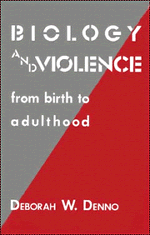Book contents
- Frontmatter
- Contents
- Foreword by Marvin E. Wolfgang
- Preface
- Introduction
- 1 Biological and environmental influences on crime
- 2 Violent criminals as children and as adults
- 3 Intelligence and crime
- 4 Biological and environmental predictors of crime
- 5 Case studies of violent and career criminals
- 6 Biology and responsibility
- Appendix: Selection and distribution of Biosocial Project variables
- References
- Author index
- Subject index
6 - Biology and responsibility
Published online by Cambridge University Press: 04 August 2010
- Frontmatter
- Contents
- Foreword by Marvin E. Wolfgang
- Preface
- Introduction
- 1 Biological and environmental influences on crime
- 2 Violent criminals as children and as adults
- 3 Intelligence and crime
- 4 Biological and environmental predictors of crime
- 5 Case studies of violent and career criminals
- 6 Biology and responsibility
- Appendix: Selection and distribution of Biosocial Project variables
- References
- Author index
- Subject index
Summary
The results of the Biosocial Project indicate that both biological and environmental factors influence criminal behavior among both juveniles and young adults. Moreover, these influences are so interdependent that separate labels designating them as “biological” or “environmental” are not always warranted. Likewise, the Project's results support a probability theory of behavior that views crime as a product of three categories of variables: predisposing, facilitating, and inhibiting (Report of the Interdisciplinary Group, 1978).
Predisposing variables can be defined as “having a necessary but not sufficient or compelling relationship with the phenomenon being studied” (Report of the Interdisciplinary Group, 1978: 30). Their presence increases the likelihood of, and may account for, a significant portion of criminal behavior. Variables include genetic, psychophysiological, neurological, and social influences. Facilitating variables “do not by themselves explain or cause the phenomena in question but, in combination with the predisposing factors, increase the probability that the behavior will occur” (Report of the Interdisciplinary Group, 1978: 31). Such factors include the use of drugs and alcohol, victim provocation, the availability of weapons, and the environmental and social context of the situation. (For a review of the literature on situational influences, and an analysis of their effect on violent behavior in the Biosocial Project sample, see Denno, 1986.) Inhibiting variables “are those which, in the presence of predisposing factors, tend to decrease the probability of the behavior from occurring at all” (Report of the Interdisciplinary Group, 1978: 33).
- Type
- Chapter
- Information
- Biology and ViolenceFrom Birth to Adulthood, pp. 123 - 126Publisher: Cambridge University PressPrint publication year: 1990



